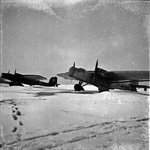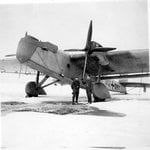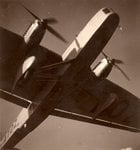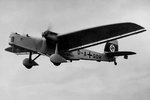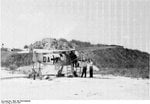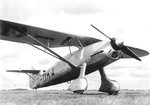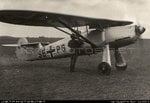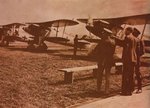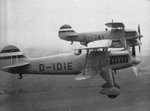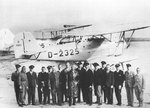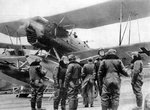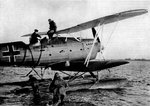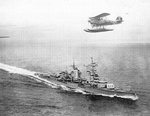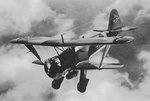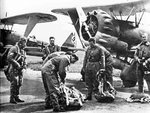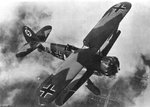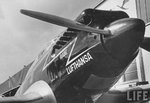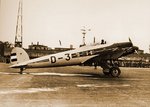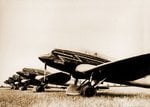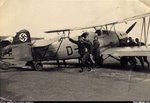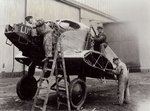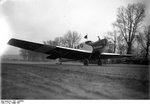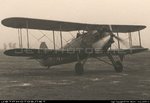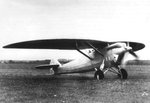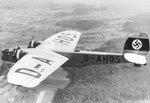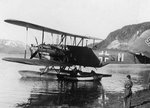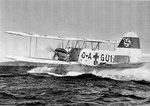Since the Treaty of Versailles forbade Germany from having an air force, German pilots had to be trained in secret from the Treaty of Versailles. Initially, civil aviation schools within Germany were used, yet only light training planes could be used in order to maintain the facade that the trainees were going to fly with civil airlines such as Lufthansa. To train its pilots on the latest combat aircraft, Germany solicited the help of its future enemy, the USSR, which was also isolated in Europe. A secret training airfield was established at Lipetsk in 1924 and operated for approximately nine years using mostly Dutch and Russian, but also some German, training aircraft before being closed in 1933. This base was officially known as 4th squadron of the 40th wing of the Red Army.
On 26 February 1935, Adolf Hitler ordered Hermann Göring to establish the Luftwaffe, breaking the Treaty of Versailles's ban on German military aviation. Germany violated the treaty without sanction from Britain, France, or the League of Nations, and neither they nor the league did anything to oppose this. Although the new air force was to be run totally separately from the army, it retained the tradition of according army ranks for its officers and airmen, a tradition retained today by united Germany's Luftwaffe and by many air forces throughout the world. It is worth noting, however, that before the official promulgation of Göring's new Luftwaffe in 1935, Germany had a paramilitary air force known as the Deutscher Luftsportverband (DLV: German air sports union). The DLV was headed by Ernst Udet and its insignia were taken over by the new Luftwaffe, although the DLV "ranks" had special names that made them sound more civilian than military. Dr. Fritz Todt, the engineer who founded the forced labor Organisation Todt, was appointed to the rank of Generalmajor in the Luftwaffe. He was not, strictly speaking, an airman, although he had served in an observation squadron during World War I and had been awarded the Iron Cross. He died in a plane crash in February 1942.
The eagle, an old symbol of the German Empire, was used as an insignia for the Luftwaffe, but in a different posture. Since 1933, when Hitler's National Socialist Party came to power, the eagle held between his claws the symbol of the party—the swastika (an old symbol of sunrise)—which was usually enveloped by an oak wreath. Göring rejected the old heraldic eagle because he felt it was too stylized, too static, and too massive; instead he chose a younger, more natural and lighter eagle with wings spread as if in flight, as he considered this a more suitable symbol for an air force. While the Wehrmacht eagle held the symbol of the National Socialist Party firmly in its claws, the Luftwaffe eagle held the swastika with only one claw while the other was bent in a threatening gesture. The Luftwaffe attempted to incorporate all military units that had anything to do with air warfare. Given the strong nazi origin and influence in the Luftwaffe, this was seen as a way to increase nazi influence in the army (alongside the other project in this respect, the formation of SS divisions), as well as boosting the personal prestige of Göring. Thus the anti-aircraft (Flak) and airborne troops (Fallschirmjäger) fell under direct Luftwaffe command, and the navy (Kriegsmarine) never established its own air branch; naval aviation was executed by the Luftwaffe. Even the aircraft flown from the (never finished) aircraft carrier Graf Zeppelin were intended to be operated by the Luftwaffe. By the middle of the war, when personnel assignments for the Luftwaffe were disproportionate to a shrinking amount of planes, the excess personnel was not transferred to the army (Heer), but instead organized into Luftwaffe Field Divisions in 1942. However, their performance as ground units was so poor that command was transferred to Heer in 1943, although they retained their name.
Spanish Civil War
The Luftwaffe had the ideal opportunity to test its pilots, aircraft and tactics in the Spanish Civil War of 1936–1939, when the Condor Legion was sent to Spain in support of the anti-Republican government revolt led by Francisco Franco. Modern machines included names which became world famous: the Junkers Ju 87 Stuka dive-bomber, Dornier Do 17 "Schnell" (fast) bomber, and the Messerschmitt Bf 109 fighter. Since the aircraft were seconded to Franco's Nationalist air force, Luftwaffe markings were replaced to avoid giving the world the impression that Germany was actively supporting the revolt. Instead of the Nazi Party's swastika on the tail, the German planes used the nationalist air force aircraft markings (a Saint Andrew's cross over a white background, painted on the rudder of the aircraft and a black disc on fuselage and wings). All aircraft in the Legion were affiliated to units given a designation ending in the number 88. For example, bombers were in Kampfgruppe 88 (combat group 88, K/88); and fighters, in Jagdgruppe 88 (fighter group 88, J/88. Following the Munich crisis, Hitler ordered the Luftwaffe be expanded by five times.
A grim foretaste of the systematic bombing of cities during World War II came in April 1937 when a combined force of German and Italian bombers under Spanish-Nationalist command destroyed most of the Basque city of Guernica in north-east Spain. This bombing received worldwide condemnation, and the collective memory of the horror of the bombing of civilians became more acute via a famous painting, named after the town, by the Cubist artist Pablo Picasso. Many feared that this would be the way that future air wars would be conducted; the Italian strategist General Giulio Douhet (who had died in 1930) had formulated theories regarding what would be dubbed "strategic bombing", the idea that wars would be won by striking from the air at the heart of the industrial muscle of a warring nation, thus demoralizing the civilian population to the point where the government of that nation would be driven to sue for peace. This was a portent of things to come, certainly, and not just during the war which would break out in Europe only months after the end of the civil war in Spain.
In fairness to the aircrews of VB/88, K/88, A/88 and J/88 who were involved, it should be noted that the destruction of the town was not the aim of the mission and that the actual targets were the roads and the Rentaria bridge. The devastation was primarily caused by the inaccuracy of bombing techniques of the day and the fact that the mass of refugees moving through the town was mis-identified as "Troop Movements". It should also be remembered that the Basque Government had previously desided to fortify the town and that there were some 2000 of their troops present. The propaganda claims that it was intended a "terror attack" are demonstrably untrue as Wolfram von Richthofen "had no time for this tactic and was at first as bewhildered about the town's destruction as everyone else".
On 26 February 1935, Adolf Hitler ordered Hermann Göring to establish the Luftwaffe, breaking the Treaty of Versailles's ban on German military aviation. Germany violated the treaty without sanction from Britain, France, or the League of Nations, and neither they nor the league did anything to oppose this. Although the new air force was to be run totally separately from the army, it retained the tradition of according army ranks for its officers and airmen, a tradition retained today by united Germany's Luftwaffe and by many air forces throughout the world. It is worth noting, however, that before the official promulgation of Göring's new Luftwaffe in 1935, Germany had a paramilitary air force known as the Deutscher Luftsportverband (DLV: German air sports union). The DLV was headed by Ernst Udet and its insignia were taken over by the new Luftwaffe, although the DLV "ranks" had special names that made them sound more civilian than military. Dr. Fritz Todt, the engineer who founded the forced labor Organisation Todt, was appointed to the rank of Generalmajor in the Luftwaffe. He was not, strictly speaking, an airman, although he had served in an observation squadron during World War I and had been awarded the Iron Cross. He died in a plane crash in February 1942.
The eagle, an old symbol of the German Empire, was used as an insignia for the Luftwaffe, but in a different posture. Since 1933, when Hitler's National Socialist Party came to power, the eagle held between his claws the symbol of the party—the swastika (an old symbol of sunrise)—which was usually enveloped by an oak wreath. Göring rejected the old heraldic eagle because he felt it was too stylized, too static, and too massive; instead he chose a younger, more natural and lighter eagle with wings spread as if in flight, as he considered this a more suitable symbol for an air force. While the Wehrmacht eagle held the symbol of the National Socialist Party firmly in its claws, the Luftwaffe eagle held the swastika with only one claw while the other was bent in a threatening gesture. The Luftwaffe attempted to incorporate all military units that had anything to do with air warfare. Given the strong nazi origin and influence in the Luftwaffe, this was seen as a way to increase nazi influence in the army (alongside the other project in this respect, the formation of SS divisions), as well as boosting the personal prestige of Göring. Thus the anti-aircraft (Flak) and airborne troops (Fallschirmjäger) fell under direct Luftwaffe command, and the navy (Kriegsmarine) never established its own air branch; naval aviation was executed by the Luftwaffe. Even the aircraft flown from the (never finished) aircraft carrier Graf Zeppelin were intended to be operated by the Luftwaffe. By the middle of the war, when personnel assignments for the Luftwaffe were disproportionate to a shrinking amount of planes, the excess personnel was not transferred to the army (Heer), but instead organized into Luftwaffe Field Divisions in 1942. However, their performance as ground units was so poor that command was transferred to Heer in 1943, although they retained their name.
Spanish Civil War
The Luftwaffe had the ideal opportunity to test its pilots, aircraft and tactics in the Spanish Civil War of 1936–1939, when the Condor Legion was sent to Spain in support of the anti-Republican government revolt led by Francisco Franco. Modern machines included names which became world famous: the Junkers Ju 87 Stuka dive-bomber, Dornier Do 17 "Schnell" (fast) bomber, and the Messerschmitt Bf 109 fighter. Since the aircraft were seconded to Franco's Nationalist air force, Luftwaffe markings were replaced to avoid giving the world the impression that Germany was actively supporting the revolt. Instead of the Nazi Party's swastika on the tail, the German planes used the nationalist air force aircraft markings (a Saint Andrew's cross over a white background, painted on the rudder of the aircraft and a black disc on fuselage and wings). All aircraft in the Legion were affiliated to units given a designation ending in the number 88. For example, bombers were in Kampfgruppe 88 (combat group 88, K/88); and fighters, in Jagdgruppe 88 (fighter group 88, J/88. Following the Munich crisis, Hitler ordered the Luftwaffe be expanded by five times.
A grim foretaste of the systematic bombing of cities during World War II came in April 1937 when a combined force of German and Italian bombers under Spanish-Nationalist command destroyed most of the Basque city of Guernica in north-east Spain. This bombing received worldwide condemnation, and the collective memory of the horror of the bombing of civilians became more acute via a famous painting, named after the town, by the Cubist artist Pablo Picasso. Many feared that this would be the way that future air wars would be conducted; the Italian strategist General Giulio Douhet (who had died in 1930) had formulated theories regarding what would be dubbed "strategic bombing", the idea that wars would be won by striking from the air at the heart of the industrial muscle of a warring nation, thus demoralizing the civilian population to the point where the government of that nation would be driven to sue for peace. This was a portent of things to come, certainly, and not just during the war which would break out in Europe only months after the end of the civil war in Spain.
In fairness to the aircrews of VB/88, K/88, A/88 and J/88 who were involved, it should be noted that the destruction of the town was not the aim of the mission and that the actual targets were the roads and the Rentaria bridge. The devastation was primarily caused by the inaccuracy of bombing techniques of the day and the fact that the mass of refugees moving through the town was mis-identified as "Troop Movements". It should also be remembered that the Basque Government had previously desided to fortify the town and that there were some 2000 of their troops present. The propaganda claims that it was intended a "terror attack" are demonstrably untrue as Wolfram von Richthofen "had no time for this tactic and was at first as bewhildered about the town's destruction as everyone else".
Last edited:

